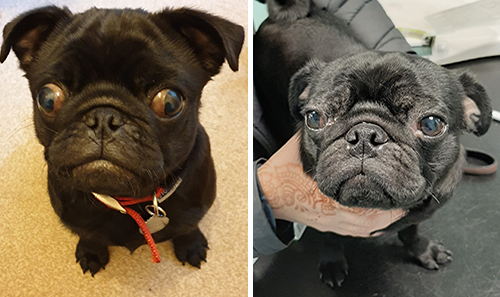Keep an eye on those eyes!
Conjunctivitis
Conjunctivitis is inflammation of the lining of the eyelids (the so called conjunctiva), eyes can be swollen, red and discharge can be seen to emerge from the corner of the eye. Conjunctivitis is more commonly seen when more flies are around as they irritate the conjunctiva and can spread infection. Treatment often consists of antibiotic eye drops to stop the infection. It can be prevented by turning horses out with an eye mask.
Uveitis
Uveitis is inflammation of the iris and related structures and can be very painful. Signs of this disease are squinting of the eye, mild discharge and a very constricted (small) pupil. Treatment is aimed at stopping the inflammation and relaxing the constricted pupil. As this disease is very painful and can cause long-term damage to the eye it is crucial that treatment is started as soon as possible. Uveitis is usually an auto-immune condition or can be caused by a bacteria known as leptospira spp.
Corneal ulcers
A corneal ulcer is a defect of the superficial layer (cornea) of the eye that can be caused by trauma to the eye, such as, rubbing of the eye, sand in the eye, or scratching of the eye by with a foreign object such as a branch of a tree. It is diagnosed by staining of the eye with fluorescein, and the defect will be colored green (as can be seen in the picture). Antibiotic drops and artificial tears are commonly used to treat these ulcers.
Injury of the eye
Injury of the eye can be caused by blunt force (such as a kick) or sometimes by a laceration. Therefore it is important that after an accident to the face the eye is thoroughly checked too. Sometimes the trauma can be obvious, but sometimes the initial injury looks very minor; however their still may be damage to the eye, so it is important to get it checked out.
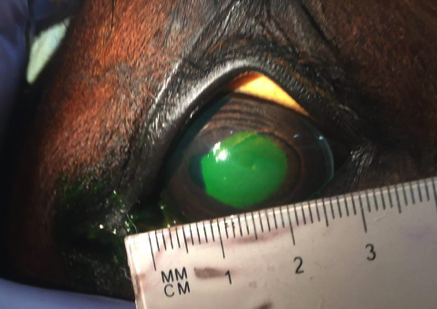
Figure – This horse has a large ulcer, obtained after he injured his eye on electrical tape. As treatment was started immediately the ulcer resolved within a week.
Besides these common problems other issues can occur to all structures of the eyes. It is good to remember that eye problems can deteriorate rapidly. It is key to call your veterinary surgeon within 24-48 hours after problems arise. Most problems can be treated successfully when treatment is started promptly. So keep an eye on those eyes!
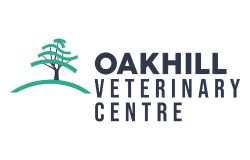
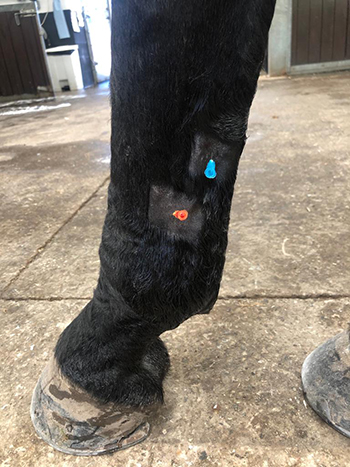 A nerve block is the deposition of local anaesthetic into the area immediately surrounding a nerve body or ending. This stops the nerve from transmitting signals relating to pain back to the brain, hence pain is prevented or “blocked”. Practically, the term nerve blocking is often used to describe the placement of nerve blocks in the truest sense, and also the deposition of local anaesthetic into joints and into the tissue surrounding the spinal cord (an epidural), rather than around nerves.
A nerve block is the deposition of local anaesthetic into the area immediately surrounding a nerve body or ending. This stops the nerve from transmitting signals relating to pain back to the brain, hence pain is prevented or “blocked”. Practically, the term nerve blocking is often used to describe the placement of nerve blocks in the truest sense, and also the deposition of local anaesthetic into joints and into the tissue surrounding the spinal cord (an epidural), rather than around nerves. 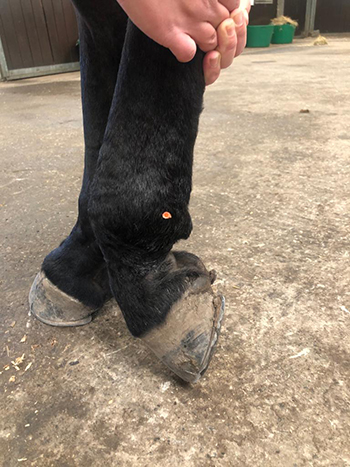 The procedure involves observing the horse moving in a straight line, on circles on both reins and on firm and soft surfaces. This allows grading and characterisation of the lameness. A nerve block is then placed, stopping the sensation of pain in a specific area. Once this has had chance to take effect, the horse is once again observed moving as previously. Any substantial reduction of lameness can therefore be attributed to pain coming from within the area that has been desensitised by the nerve block. If the lameness is unchanged, it can be deduced that the source of pain is not within the blocked area of the limb, and further nerve blocks can be performed to desensitise other area of the limb until the source of lameness is known.
The procedure involves observing the horse moving in a straight line, on circles on both reins and on firm and soft surfaces. This allows grading and characterisation of the lameness. A nerve block is then placed, stopping the sensation of pain in a specific area. Once this has had chance to take effect, the horse is once again observed moving as previously. Any substantial reduction of lameness can therefore be attributed to pain coming from within the area that has been desensitised by the nerve block. If the lameness is unchanged, it can be deduced that the source of pain is not within the blocked area of the limb, and further nerve blocks can be performed to desensitise other area of the limb until the source of lameness is known. 